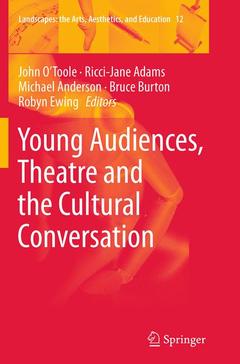Description
Young Audiences, Theatre and the Cultural Conversation, 2014
Landscapes: the Arts, Aesthetics, and Education Series, Vol. 12
Coordinators: O'Toole John, Adams Ricci-Jane, Anderson Michael, Burton Bruce, Ewing Robyn
Language: English
Publication date: 09-2016
Support: Print on demand
Publication date: 01-2014
201 p. · 15.5x23.5 cm · Hardback
Description
/li>Contents
/li>Comment
/li>
Foreword.- Acknowledgments.- Part I TheatreSpace Project Partners and Case Studies.- Chapter 1: Introduction by John O’Toole. Interlude: The TheatreSpace Case Studies 1 and 2 The Importance of Being Earnest - Queensland Theatre Company, Anatomy Titus: Fall of Rome – Bell Shakespeare, Sydney.- Chapter 2: The Project, its Partners and its Purposes by Michael Anderson and Josephine Fleming.- Interlude: The TheatreSpace Case Studies 3 and 4, Yibiyung – The Malthouse Theatre, Melbourne, Fake Porno – Brisbane Powerhouse.- Chapter 3: Access and the Practicalities of Attendance by Christine Sinclair.- Interlude: The TheatreSpace Case Studies 5 and 6, The Removalists – Sydney Theatre Company, Goodbye Vaudeville Charlie Mudd – Arena Theatre, Melbourne.- Chapter 4: The Context of the Performance Event by Madonna Stinson.- Interlude: The TheatreSpace Case Studies 7 and 8, The Shape of a Girl – Sydney Opera House, The Shape of a Girl – The Arts Centre, Melbourne.- Chapter 5: The Education Landscape by Kate Donelan with Richard Sallis.- Interlude: The TheatreSpace Case Studies 9 and 10, God of Carnage – Melbourne Theatre Company, The True Story of Butterfish – Brisbane Powerhouse.- Chapter 6: Young Audiences from the Educators' Perspective by Robyn Ewing, Josephine Fleming, Bruce Burton and Madonna Stinson.- Interlude: The TheatreSpace Case Studies 11 and 12, Up Jumped the Devil – Queensland Performing Arts Centre, World Theatre Festival – Brisbane Powerhouse.- Chapter 7: The Industry Partners’ Perceptions by Josephine Fleming, Robyn Ewing and John Hughes.- Interlude: The TheatreSpace Case Studies 13 and 14, The Beauty Queen of Leenane – Sydney Theatre Company, King Lear – Bell Shakespeare, Sydney.- Chapter 8: Engagement and Liveness by Penny Bundy.- Interlude: The TheatreSpace Case Studies 15 and 16, Moth – Arena Theatre, Melbourne, The Threepenny Opera – The Malthouse Theatre , Melbourne.- Chapter 9: Building Theatre Confidence by Christine Sinclair and Ricci-Jane Adams.- Interlude: The TheatreSpace Case Studies 17 and 18, Fat Pig – Queensland Theatre Company, Moth - Sydney Opera House.- Chapter 10: Theatre Literacy by Bruce Burton, Penny Bundyand Robyn Ewing.- Interlude: The TheatreSpace Case Studies 19 and 20, Dead Man’s Cell Phone – Melbourne Theatre Company, The Kind of Ruckus - The Arts Centre, Melbourne.- Chapter 11: ‘It’s Real’ - Genre and Performance Style by Angela O’Brien.- Interlude: The TheatreSpace Case Study 21, Wicked – Queensland Performing Arts Centre.- Chapter 12: Conclusion – a Continuum for Planning by Christine Sinclair, Ricci-Jane Adams and John O’Toole
Offers rare insights on how adolescent and post-adolescent young audiences experience and appreciate the theatre
Results from a six year study involving three Australian states and thirteen major performing arts companies
A thorough investigation into the extent to which young audiences are part of our society's cultural conversation

